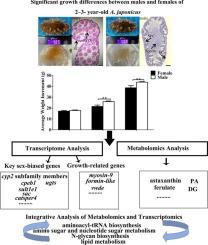转录组学和代谢组学的综合应用为日本刺参两性二态性的研究提供了新的思路
IF 2.2
2区 生物学
Q4 BIOCHEMISTRY & MOLECULAR BIOLOGY
Comparative Biochemistry and Physiology D-Genomics & Proteomics
Pub Date : 2025-09-23
DOI:10.1016/j.cbd.2025.101643
引用次数: 0
摘要
海参(Apostichopus japonicus)是中国重要的商业养殖品种。研究结果表明,性腺分化的成年雄性海参比雌性海参具有更大的生长优势。了解日本刺参性别二型现象的分子基础,对制定水产养殖性别控制育种策略具有重要意义。在这项研究中,我们整合了睾丸和卵巢的转录组学和代谢组学分析,以阐明基因表达和代谢物谱的差异。关键的性别偏向基因,包括cyp2亚家族成员,cpeb1和sult1e1,主要在卵巢中表达,而sac和catsper4在睾丸中表达,这表明它们在性别发育中具有潜在的作用。此外,与卵巢相比,睾丸中免疫相关基因(肌球蛋白-9、形成蛋白样和vwde)的表达明显更高,代谢产物如虾青素和阿魏酸盐的表达也更丰富,这表明雄性可能比雌性具有更强的免疫能力。与睾丸相比,ugts在分化卵巢中的表达水平更高,这表明雌性性腺可能由于其在皂素生物合成中的作用而具有更大的营养价值。此外,途径富集分析显示,卵巢表现出增强的碳代谢、氨基酸生物合成、嘌呤和嘧啶代谢,这表明与精子发生相比,卵子发生对能量的更高需求可能有助于生长过程中的两性二态性。这些发现为研究海参性别偏倚代谢和调控机制提供了新的思路,为进一步研究海参性腺发育的调控机制奠定了基础。本文章由计算机程序翻译,如有差异,请以英文原文为准。

Integrated application of transcriptomics and metabolomics provides insights into sexual dimorphism in Apostichopus japonicus
Sea cucumber (Apostichopus japonicus) is a commercially important aquaculture species in China. Research findings have indicated that adult male sea cucumbers with differentiated gonads have a greater growth advantage compared to females. Understanding the molecular basis of sexual dimorphism in A. japonicus is critical for developing sex control breeding strategies in aquaculture. In this study, we integrated transcriptomic and metabolomic analyses of testes and ovaries to elucidate differences in gene expression and metabolite profiles. Key sex-biased genes, including cyp2 subfamily members, cpeb1, and sult1e1, were predominantly expressed in the ovaries, whereas sac and catsper4 showed specific expression in the testes, suggesting their potential roles in sex development. Moreover, compared to the ovaries, the testes exhibited significantly higher expression of immune-related genes (myosin-9, formin-like, and vwde), along with greater abundance of metabolites such as astaxanthin and ferulate, suggesting that males may possess stronger immune capacity than females. Higher expression levels of ugts in differentiated ovaries compared to testes suggest that female gonads may possess greater nutritional value due to their role in saponin biosynthesis. Additionally, pathway enrichment analyses revealed that ovaries exhibited enhanced carbon metabolism, amino acid biosynthesis, and purine and pyrimidine metabolism, suggesting that the higher energy demands of oogenesis compared to spermatogenesis may contribute to sexual dimorphism in growth. These findings provide novel insights into sex-biased metabolic and regulatory mechanisms and lay a foundation for future studies aimed at elucidating the regulatory mechanisms of gonadal development in sea cucumbers.
求助全文
通过发布文献求助,成功后即可免费获取论文全文。
去求助
来源期刊
CiteScore
5.10
自引率
3.30%
发文量
69
审稿时长
33 days
期刊介绍:
Comparative Biochemistry & Physiology (CBP) publishes papers in comparative, environmental and evolutionary physiology.
Part D: Genomics and Proteomics (CBPD), focuses on “omics” approaches to physiology, including comparative and functional genomics, metagenomics, transcriptomics, proteomics, metabolomics, and lipidomics. Most studies employ “omics” and/or system biology to test specific hypotheses about molecular and biochemical mechanisms underlying physiological responses to the environment. We encourage papers that address fundamental questions in comparative physiology and biochemistry rather than studies with a focus that is purely technical, methodological or descriptive in nature.

 求助内容:
求助内容: 应助结果提醒方式:
应助结果提醒方式:


